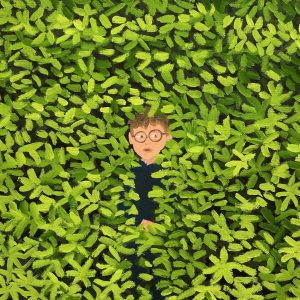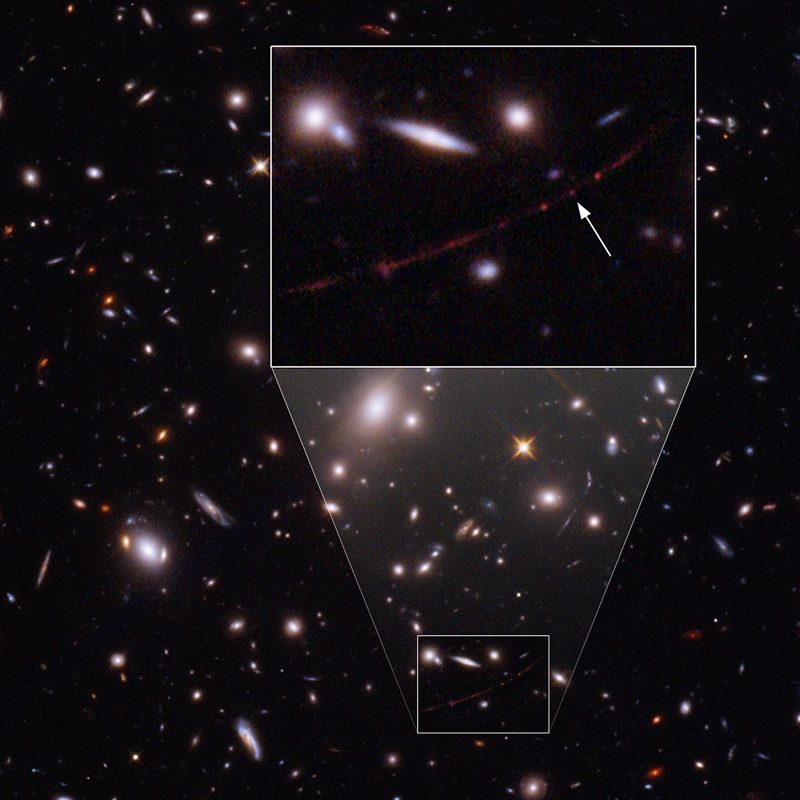Link About It: This Week’s Picks
Jazz history, black holes explained, whimsical virtual exhibitions and discoveries from ancient ruins

10 Pioneering Women Who Helped Shape Jazz
 “These jazz women were pioneers, and huge proponents in disseminating jazz and making it a global art form,” Hannah Grantham (musicologist at the National Museum of African American History and Culture) tells The New York Times, whose list of 10 overlooked women through the genre’s history includes pianist Lovie Austin, trumpeter Valaida Snow and violinist Ginger Smock. Though an inordinate amount of attention is placed on men in jazz, women played crucial roles on stage and behind the scenes since the genre’s beginnings—whether as composers, performers, arrangers or artist managers. “Buffeted by sexism from venue owners and record companies in the United States, they often went abroad to pursue careers in Europe or even Asia,” writes Giovanni Russonello. Valaida Snow—nicknamed the “Queen of the Trumpet” and “Little Louis”—toured for years from China to Egypt, Japan and beyond. Grantham adds, “I don’t think they’ve been given enough credit for that, because of their willingness to go everywhere.” Read more at The New York Times.
“These jazz women were pioneers, and huge proponents in disseminating jazz and making it a global art form,” Hannah Grantham (musicologist at the National Museum of African American History and Culture) tells The New York Times, whose list of 10 overlooked women through the genre’s history includes pianist Lovie Austin, trumpeter Valaida Snow and violinist Ginger Smock. Though an inordinate amount of attention is placed on men in jazz, women played crucial roles on stage and behind the scenes since the genre’s beginnings—whether as composers, performers, arrangers or artist managers. “Buffeted by sexism from venue owners and record companies in the United States, they often went abroad to pursue careers in Europe or even Asia,” writes Giovanni Russonello. Valaida Snow—nicknamed the “Queen of the Trumpet” and “Little Louis”—toured for years from China to Egypt, Japan and beyond. Grantham adds, “I don’t think they’ve been given enough credit for that, because of their willingness to go everywhere.” Read more at The New York Times.
Avio Interiors Proposes Reverse Airplane Seating
 Italian aviation company Avio Interiors’ first concept, Janus, proposes reversing the position of the center seat in economy travel “to ensure the maximum isolation between passengers seated next to each other,” the brand explains. Further, easy-to-clean shields surround each seat and denies breath direct access to adjacent seats. This configuration could offer extra protection to passengers—though one may wonder what it would be like to take-off or land facing backward. Read more at designboom.
Italian aviation company Avio Interiors’ first concept, Janus, proposes reversing the position of the center seat in economy travel “to ensure the maximum isolation between passengers seated next to each other,” the brand explains. Further, easy-to-clean shields surround each seat and denies breath direct access to adjacent seats. This configuration could offer extra protection to passengers—though one may wonder what it would be like to take-off or land facing backward. Read more at designboom.
Discovery in Pompeii Suggest Romans Invented Recycling
 The Pompeii ruins continue to reveal fascinating information from ancient history, and this time researchers found that Romans organized and recycled garbage. Scientists initially believed large piles of plaster and ceramic found outside the city walls were the result of an earthquake that occurred years before Mount Vesuvius erupted in 79AD. But, as professor Allison Emmerson explains, “The piles outside the walls weren’t material that’s been dumped to get rid of it. They’re outside the walls being collected and sorted to be resold inside the walls.” The team of researchers also “used soil samples to trace the movement of rubbish across the city” allowing them to understand where the garbage originated, and how it was moved around for reuse. Find out more at The Guardian.
The Pompeii ruins continue to reveal fascinating information from ancient history, and this time researchers found that Romans organized and recycled garbage. Scientists initially believed large piles of plaster and ceramic found outside the city walls were the result of an earthquake that occurred years before Mount Vesuvius erupted in 79AD. But, as professor Allison Emmerson explains, “The piles outside the walls weren’t material that’s been dumped to get rid of it. They’re outside the walls being collected and sorted to be resold inside the walls.” The team of researchers also “used soil samples to trace the movement of rubbish across the city” allowing them to understand where the garbage originated, and how it was moved around for reuse. Find out more at The Guardian.
YouTube + Tribeca Enterprises Partner on We Are One: A Global Film Festival
 Starting 29 May, YouTube will host a 10-day digital film festival, in partnership with Tribeca Enterprises (the organization behind NYC’s Tribeca Film Festival), that will feature programming by 20 of the world’s most influential festivals—Berlin, Sundance, Cannes, Toronto, Venice, New York, BFI London and the Annecy International Animated Film Festival included. Although these at-home screenings will be free, organizers hope that viewers will donate to their intended charity, the World Health Organization’s COVID-19 Solidarity Response Fund. This news comes as the Tribeca Film Festival moves its annual awards ceremony to Instagram on 29 April. And, the industry news that the Academy will consider streaming-only films for Oscars 2021. Read more about We Are One’s partners at Tech Crunch.
Starting 29 May, YouTube will host a 10-day digital film festival, in partnership with Tribeca Enterprises (the organization behind NYC’s Tribeca Film Festival), that will feature programming by 20 of the world’s most influential festivals—Berlin, Sundance, Cannes, Toronto, Venice, New York, BFI London and the Annecy International Animated Film Festival included. Although these at-home screenings will be free, organizers hope that viewers will donate to their intended charity, the World Health Organization’s COVID-19 Solidarity Response Fund. This news comes as the Tribeca Film Festival moves its annual awards ceremony to Instagram on 29 April. And, the industry news that the Academy will consider streaming-only films for Oscars 2021. Read more about We Are One’s partners at Tech Crunch.
Explaining Black Holes in Five Ways
 Research astronomer Varoujan Gorjian (whose team at NASA is called Structure of the Universe Group) explains Black Holes to five different individuals whose understanding exists at five different levels: a five-year old, a teenager, a grad student studying astronomy, and an expert. In the fascinating video for WIRED, super-personable Gorjian begins by explaining how gravity works and ends up discussing low-luminosity active galactic nuclei. While our understanding of the fascinating phenomenon varies, this video is sure to uncover some cosmic facts—and in an accessible manner. Learn more at WIRED.
Research astronomer Varoujan Gorjian (whose team at NASA is called Structure of the Universe Group) explains Black Holes to five different individuals whose understanding exists at five different levels: a five-year old, a teenager, a grad student studying astronomy, and an expert. In the fascinating video for WIRED, super-personable Gorjian begins by explaining how gravity works and ends up discussing low-luminosity active galactic nuclei. While our understanding of the fascinating phenomenon varies, this video is sure to uncover some cosmic facts—and in an accessible manner. Learn more at WIRED.
Jean Jullien’s First-Ever Virtual Exhibition, “Home Slice”
 “With painting, I enjoy trying to tell more, to visually translate moments. The time told is longer, the action less immediate, the point less important,” French artist Jean Jullien explains in text that appears throughout the interactive exhibition, Home Slice—his first-ever online show. Presented by San Francisco’s Chandran Gallery, the solo showcase acts as a prequel to the painter’s NYC exhibit (titled Slices), which aims to open in September. Home Slice is more than a website of charming illustrations paired with whimsical paintings of private moments (all set to a soundtrack); it offers a periscope into Jullien’s process, and a thoughtfully considered procession through the collection. Further, a percentage of the proceeds benefit the efforts of Fondation de France‘s direct support of healthcare workers. Check out the exhibition at homeslice.show.
“With painting, I enjoy trying to tell more, to visually translate moments. The time told is longer, the action less immediate, the point less important,” French artist Jean Jullien explains in text that appears throughout the interactive exhibition, Home Slice—his first-ever online show. Presented by San Francisco’s Chandran Gallery, the solo showcase acts as a prequel to the painter’s NYC exhibit (titled Slices), which aims to open in September. Home Slice is more than a website of charming illustrations paired with whimsical paintings of private moments (all set to a soundtrack); it offers a periscope into Jullien’s process, and a thoughtfully considered procession through the collection. Further, a percentage of the proceeds benefit the efforts of Fondation de France‘s direct support of healthcare workers. Check out the exhibition at homeslice.show.
Online Tools for Making Comics
 FJ.D. Biersdorfer provides plenty of resources for making your own comic strips—from online tools and downloadable applications to guides for putting pen or paint to paper. “Got a tale to tell but don’t want to bang it out as a traditional book? Try doing it as a digital comic—and ignore anyone who thinks visual narratives are a lesser art form or basic fodder for Hollywood action movies,” she writes for the The New York Times. Biersdorfer suggests starting by familiarizing yourself with the classics like Peanuts, Black Panther and The New Yorker’s one-liners. Then, choose your medium. If opting for online work, then Canva, Pixton and Storyboard That are your best bets. The ComicBook app for iOS offers assistance for photo-based stories. Medibang Paint lets you draw using your finger or a stylus on your touchscreen. For the full guide, visit The New York Times.
FJ.D. Biersdorfer provides plenty of resources for making your own comic strips—from online tools and downloadable applications to guides for putting pen or paint to paper. “Got a tale to tell but don’t want to bang it out as a traditional book? Try doing it as a digital comic—and ignore anyone who thinks visual narratives are a lesser art form or basic fodder for Hollywood action movies,” she writes for the The New York Times. Biersdorfer suggests starting by familiarizing yourself with the classics like Peanuts, Black Panther and The New Yorker’s one-liners. Then, choose your medium. If opting for online work, then Canva, Pixton and Storyboard That are your best bets. The ComicBook app for iOS offers assistance for photo-based stories. Medibang Paint lets you draw using your finger or a stylus on your touchscreen. For the full guide, visit The New York Times.
Send Yourself a Postcard and Donate to Important Organizations
 Conceptualized by Denver-based design agency Cultivator, the “Remind Me What Matters” project was created to be “a reminder that even in the toughest times, something positive can always come out of it.” The activation is charitable in nature, but also encourages people to be kind to those around us, and to ourselves. In order to take part, begin by simply choosing a postcard from Cultivator’s collection. Each one costs $1, an amount that will be split between five Colorado non-profits: Food Bank of the Rockies, American Nurses Foundation, Denver Small Business Relief Fund, Help Colorado Now, and Robbie’s Hope. (Additional donations can be made at checkout.) Printed with your personalized message, the postcard will be mailed on a random date in the future. Whether a positive reminder to yourself, a note of to a friend, or a poem for a loved one, these postcards benefit many. See more at their site.
Conceptualized by Denver-based design agency Cultivator, the “Remind Me What Matters” project was created to be “a reminder that even in the toughest times, something positive can always come out of it.” The activation is charitable in nature, but also encourages people to be kind to those around us, and to ourselves. In order to take part, begin by simply choosing a postcard from Cultivator’s collection. Each one costs $1, an amount that will be split between five Colorado non-profits: Food Bank of the Rockies, American Nurses Foundation, Denver Small Business Relief Fund, Help Colorado Now, and Robbie’s Hope. (Additional donations can be made at checkout.) Printed with your personalized message, the postcard will be mailed on a random date in the future. Whether a positive reminder to yourself, a note of to a friend, or a poem for a loved one, these postcards benefit many. See more at their site.
Mattel’s Everyday Heroes Action Figure Line
 Mattel honors essential workers with their new #ThankYouHeroes line from Fisher-Price. This diverse roster of everyday hero action figures includes four types of nurses, EMTs, doctors and delivery drivers, as well as a Little People Community Champions set that consists of a doctor, nurse, EMT, delivery driver, and grocery store worker. The individual figures can be purchased for $20—with $15 of those dollars going to the #FirstRespondersFirst initiative from sales now through 31 May. Read more about the collection and Mattel’s contributions at Mashable.
Mattel honors essential workers with their new #ThankYouHeroes line from Fisher-Price. This diverse roster of everyday hero action figures includes four types of nurses, EMTs, doctors and delivery drivers, as well as a Little People Community Champions set that consists of a doctor, nurse, EMT, delivery driver, and grocery store worker. The individual figures can be purchased for $20—with $15 of those dollars going to the #FirstRespondersFirst initiative from sales now through 31 May. Read more about the collection and Mattel’s contributions at Mashable.
30 Years of Photos From the Hubble Telescope
 Fresh off a celebration for the Hubble Space Telescope’s 30th birthday, National Geographic took time to peruse and publish select photos from the remarkable research tool’s past three decades. Living well beyond its initial 10-year term, the telescope has helped agencies answer long-held questions and inspire generations to continue searching. From “How old is the universe?” (13.8 billion years old) to “Do black holes actually exist? (yes, with frightening ferocity),” plenty of the foundational equations and discoveries used to inform space research today came courtesy of Hubble. “One of Hubble’s lasting achievements will be how it showed the public the wonders of the universe,” Kenneth Sembach, director of the Space Telescope Science Institute, tells NatGeo. See some of the incredible images there.
Fresh off a celebration for the Hubble Space Telescope’s 30th birthday, National Geographic took time to peruse and publish select photos from the remarkable research tool’s past three decades. Living well beyond its initial 10-year term, the telescope has helped agencies answer long-held questions and inspire generations to continue searching. From “How old is the universe?” (13.8 billion years old) to “Do black holes actually exist? (yes, with frightening ferocity),” plenty of the foundational equations and discoveries used to inform space research today came courtesy of Hubble. “One of Hubble’s lasting achievements will be how it showed the public the wonders of the universe,” Kenneth Sembach, director of the Space Telescope Science Institute, tells NatGeo. See some of the incredible images there.
Link About It is our filtered look at the web, shared daily in Link and on social media, and rounded up every Saturday morning.












